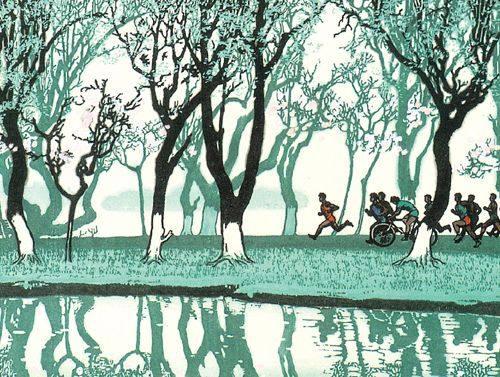走进世界的“西湖陆”
2012-04-29阿童
阿童



五月的姹紫嫣红之中,有一位精神矍铄的老人站在游人如织的西子湖边。清风拂过,他的脸上始终浮现着微微的笑意。西湖,给了他艺术创作的灵思妙感;他,也用一把刻刀将西湖展示给了全世界。
这位老人,就是人称“西湖陆”的中国美术学院教授、著名版画艺术家陆放先生。欧洲、美洲、东南亚……陆放先生曾到世界各地讲学、交流、展覽,他和他的水印木刻西湖作品享誉世界。中国美术馆、大英博物馆、前苏联莫斯科博物馆、法国巴黎造型艺术中心博物馆、美国波特兰艺术馆等著名学术收藏机构均将他的“西湖”版画热情揽入怀中。因为他,给被誉为版画“国粹”的木版水印技法,融入现代的生命力。更将传统的木刻水印技法与现代木刻版画艺术相融合,在表现“西湖”这一主题上,达到了超然的和谐,将西湖的含蓄娇藏、清雅柔美表现得淋漓尽致。1996年,中国版画家协会为表彰陆放先生的杰出贡献,特授予他版画界最高荣誉——“鲁迅版画奖”。
正值浙江省与日本静冈县正式结为友好省县30周年,笔者再度拜访了这位著名的中国版画艺术家,倾听他与版画的故事,与他分享将中国版画传播到世界的自豪。
陆放先生是江苏昆山人,自小就藏着对西湖的向往。1955年,当他考入美院附属中学的那一天,他终于和梦里的西子见面了。看惯了浩淼的太湖,那波光潋滟的西子湖,在陆放眼里显得清秀灵巧。更为幸运的是,从那时起,他的住所就一直没有迁动;数十年来,这座与西湖近在咫尺的寓所,便成了他亲近西湖的最好理由。朝赏夕伴,西湖就住进了他的生命里。
有一年初夏的雨后,已成为浙江美术学院(现为中国美术学院)版画系教授的陆放独自来到苏堤边。一幅怡人的景象打动了他:眼前的堤岸缓缓地延伸到湖里去,湖水又慢慢地漫上来,犹如湖水和堤岸在深情拥抱;两边的杨柳倒映在水面,恰似一位出浴少女对镜梳妆……他从心底里赞叹:杭州西湖真可谓集自然美、人文美、伦理美于一体,达成美的极致!陆放把西湖之美收进了心扉。回去之后,他创作了第一幅水印木刻西湖作品《苏堤春晓》。从此,陆放便与西湖越发亲近,授课之余,他跑遍了西湖的角角落落;刻刀下、木版上,一幅幅描摹西湖的作品也呼之而来。
潘天寿先生说:“西湖好看入画难。”西子湖的风情,不仅在于她四季各不同,雨晴各相宜,更在于她有丰富深厚的人文内涵。要抓住西湖的情态,概括出西湖的娇韵,却非一朝一夕可以达到。因此,不论是严冬酷暑,还是昏晨雨夕,陆放先生常常会漫步湖滨,驻足湖畔,时时刻刻细细品味,揣摩西湖的含蓄清灵,一有所得,即掏出纸笔,把稍纵即逝的感受记录下来。50余年来,陆放为西湖描画过无以计数的小稿速写,终于以诗人般的灵性,品读出西湖的种种神韵,并以独特的水印版画技巧去诠释西湖之美。古人认为游西湖,宜于月夜、雨中、雾里、雪后,陆放教授也特别喜爱表现晨昏月中、烟雨迷濛、银妆素裹的西湖。他的刀笔之下,诗情画意相融,妙趣墨韵盎然。西湖的烟柳、西湖的荷花、西湖的秋月……一幅幅具有西子情韵的代表性作品《烟雨西子》《清晨奏鸣》《西泠仲夏》《平湖秋月》《三潭印月》等广受好评。陆放先生和他的作品也因此得到国际版画界的高度评价和悉心典藏。
1982年4月20日,浙江省与日本静冈县正式结为友好省县关系。同年,由静冈县主办,浙江省协助的“静冈县中国浙江省展览会”在静冈县刚刚落成的静冈产业馆隆重举行。由于展览会上需要展现西湖风光的中国艺术作品,主办方在展会前辗转找到陆放先生,请求送去10幅作品参展。当作品抵达静冈产业馆展出后,日本的观众们震惊了!他们从来没有看到过这样散发着如此清雅气息、具有中国水墨画神韵的版画作品!主办方立即诚恳致电陆放先生,请求收藏这些作品。但是考虑到这些具有代表性意义的精品力作应该留在中国,陆放委婉地拒绝了对方的请求。
后来,日方又几度邀请,甚至由国会议员出面,陆放先生才于1991年带着他之后创作的80余幅版画作品,前往日本举办了他的个人展览。展览大获成功,所有的参展作品均被日本的藏家们留下。
1994年,美国马里兰学院院长亲自发出邀请,请陆放先生去美国进行为期两个月的讲学。这次的讲学为中国现代水印木刻版画技法传入美洲大地播下了种子。法国、俄罗斯、菲律宾……去世界各地交流、讲学,陆放带着“西湖”版画跑过了欧洲很多著名博物馆,但他却从未看到过一幅水印版画。而唯一拥有浮世绘时代传自中国的水印技术的邻邦日本,也只有带着浓厚平版套色油印个性的作品。
于是,他进一步借鉴始于明代南京十竹斋画坊的技法,摒弃了一般版画中黑白色调大量运用的特点,在保留木刻版画的刀味与木味的基础上,大胆采用色彩变化来丰富画面,并通过套色宣纸水印中的“水晕”技法,使传统木刻水印在表现“西湖”这一母题上达到了内容与形式的高度和谐。其中最难掌握的就是宣纸上的水分和颜色,对于一幅作品中水分的掌握,要经过很多次实验。水是流动的,于是水印版画是活的。陆放先生说,即使把我的刻版拿去,也难以印制出我的作品神韵。
版画创作是寂寞的。陆放先生的一幅版画作品,一般至少需要两三个月甚至更长的时间来完成。对于人们“版画就是印出来的”这一偏颇的理解。陆放先生用了一个时间的比对来说明艺术创作的艰辛。印一张版画,和一位国画家绘制一幅四尺整张国画山水的时间相当;而刻一套印版,则与一位油画家画完一幅数米长的大幅油画的时间相近。并且,按照国际惯例,版画的印数有严格的规定,一套版子,只能印制25张。“国画创作是做加法,油画创作是做加减法,版画则是做减法。每下一刀都决定着作品的成败。”陆放先生说。
50余年与西湖相伴,西湖的一情一景都成笔在胸,可陆放的西湖系列版画尚不足30件,令人咋舌叹奇。陆放先生说,一是创作难度大,3个月创作一幅,不能有很多数量;二是西湖乃自然、人文之大美,不是所有风景都能以版画的形式来表现。因此,陆放先生一幅幅清润华滋、水气流动的作品弥足珍贵。水印木刻版画作品《断桥残雪》被中国美术馆收藏,《苏堤春晓》、《晨曲》被大英博物馆收藏,《银姿》被前苏联莫斯科博物馆收藏,《瑞雪》被法国巴黎造型艺术中心博物馆收藏,《雪花飘飘》被美国波特兰艺术馆收藏……世界各大博物馆的青睐,足以说明陆放“西湖”版画的价值和意义。
去年秋天,“陆放藏书票博物馆”在江南名山莫干山落成,举办过无数次个展的陆放先生,仍无私地将一生的艺术创作与观者分享……
传承了2000多年的水印木刻技法,是中华民族的智慧结晶,被称为版画界的“国粹”!当石版、铜版、锌版、丝网等版画技术在世界版画创作中盛行的时候,这一种清韵流转、富有水墨之美的版画艺术,属于西湖,属于中国!□
Master Recreates West Lake in Prints
By A Tong, our special contributor
Lu Fang is a professor of watercolor woodblock printing with China Academy of Art in Hangzhou. Within the circles of art, how-ever, he is famed as West Lake Lu. His West Lake masterpieces are in the collections of such prestigious museums as China Art Mu-seum, British Museum, Moscow Art Museum, the Centre National Des Arts Plastiques in Paris, and Portland Museum of Art of the United States.
Born in 1932 in Kunshan in neighboring Jiangsu Province, Lu Fang came to Hangzhou in 1955 when he began to study at the af-filiated middle school of the Zhejiang Academy of Fine Arts, the predecessor of present days China Academy of Art. He fell in love with the West Lake at the first sight. After four years study at the academy, he began to teach the printmaking art at his alma mater in 1960. Though he loved the West Lake dearly and he has been living in the same house just a stones throw from the lake over decades, years had elapsed before he was able to find a way to reproduce the lake in his watercolor block printing art. One summer day after rain, he strolled along the Su Causeway on the lake and found he was fascinated by the way the lake, the willows, the causeway interacted with each other. He thought he had at last discovered his artistic bond with the lake. Back home that day, the inspired artist started carving his impression and memory onto wood blocks. This was his first art reproduction of the lake.
The legendary lake has been a centerpiece of poems and essays and paintings since very ancient times. Pan Tianshou (1898-1971), a prominent master painter and director of Zhejiang Academy of Fine Arts, famously commented on the difficulty of painting the West Lake, saying that the beauty of the lake was hard to paint.
That is partly why there are few modern masterpieces of the West Lake and why Lu Fangs watercolor woodblock prints of the West Lake are so highly appreciated. Lu Fang is one of the few artists who have successfully translated their love of the West Lake into image artworks.
His first international fame came in the early 1980s. On April 20, 1982, Zhejiang Province and Shizuoka Prefecture of Japan bonded as twin cities. Zhejiang decided to hold an exhibition in Shizuoka. Organizers from Zhejiang looked for artworks that could convey the beauty of the West Lake. They approached Lu. Lus ten prints of the West Lake made a sensation at the exhibition. The Japanese visitors were astonished by the soul-touching artistry oozing from the watercolor block prints. They had never seen anything like this before. The Japanese side phoned Lu Fang, asking if it was possible to buy the ten masterpieces. Lu declined on the grounds that the pieces should stay in China.
Over the following years, Lu was approached many times to hold an exhibition in Japan. It was not until 1991 that Lu Fang took more than 80 pints to Japan for a solo exhibition. It was a success. Collectors bought all the exhibits. Kitaoka Fumio (1918-2007), presumably the best printmaker of Japan in his lifetime, came all the way to visit Lu in Hangzhou. He proposed to exchange one of his artworks for one of Lu. Lu agreed, but declined for another ex-change.
Master Lu is more than a printmaker who captures the beauty of the West Lake. He is an innovative watercolor block printer. Based on the techniques of Ten Bamboos Studio of Nanjing of the Ming Dynasty (1368-1644), where watercolor woodblock printing was invented and perfected, Lu developed sophisticated printing tech-niques. He remarks that other people would not be able to print the style and charm well even if they use his woodblocks.
As a master of watercolor block printing, Lu came to internation-al fame for a reason. While he created masterpieces in this special printing genre, most foreign printmakers had never seen the Chi-nese watercolor woodblock printing. Lu was invited to give lectures and teach in special courses.
For Lu, printmaking is a lonely enterprise. It usually takes him three months to produce a work of art. Some people mistakenly think that, since printmaking is just a way of printing, how difficult would it be to print things? According to his calculation, making a print usually takes as much time as a traditional Chinese artist cre-ates a painting on a piece of four-foot rice paper. Carving a full set of blocks takes as much time as an oil painter creates an oil painting that is several meters long. His prints are precious simply because he can make no more than 25 prints on a set of blocks. This is a rule followed more or less by all the printmakers in the world.
Though Lu Fang has known the lake for more than 50 years, the number of his print artworks of the lake is less 30. It is only natural. It takes him about three months to complete carving a set and it takes him more time to find a new way to reproduce a scene of the lake. It is because, though the lake embodies the best of history and culture and gardening, it is hard to capture a right moment, right angle to make the lake look beautiful on a print. □
